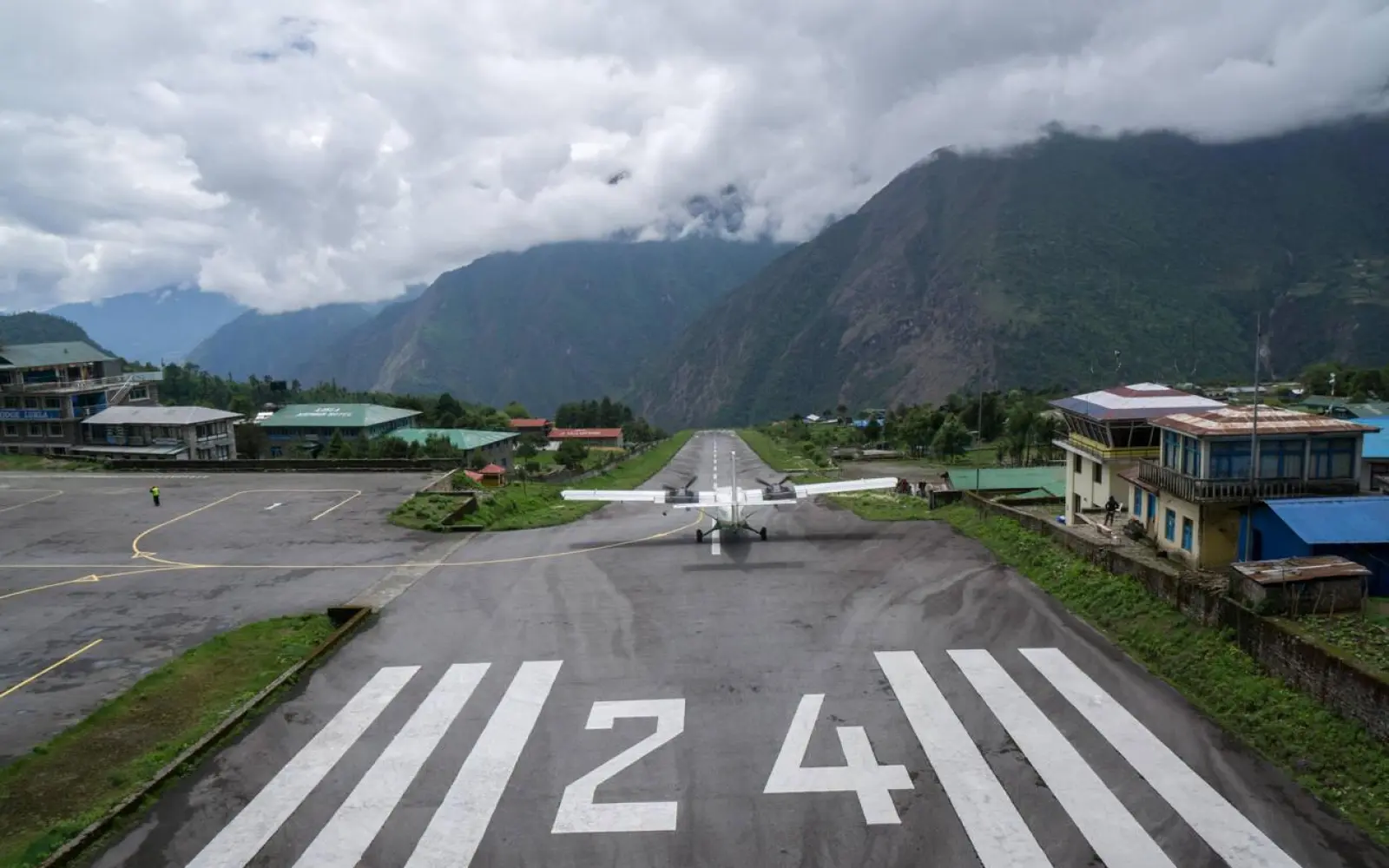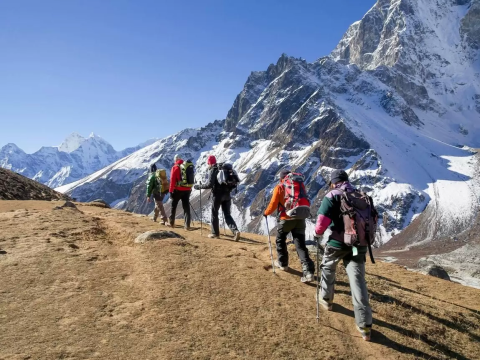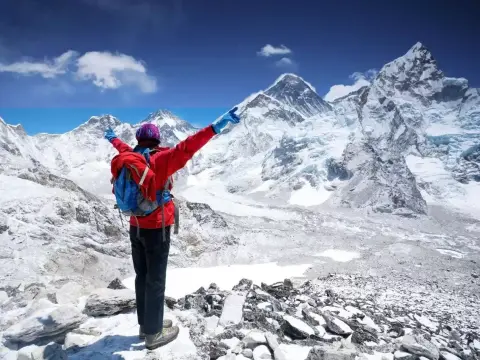Is Everest Base Camp Trekking Hard?
Is Everest Base Camp Trekking Hard?The Everest Base Camp (EBC) trek is considered challenging but achievable for most trekkers with proper preparation...

Lukla Airport, officially known as Tenzing-Hillary Airport, is infamous for being the most dangerous airport in the world. Situated high in the mountains of eastern Nepal, this tiny airstrip serves as the primary gateway for trekkers and mountaineers heading toward the Everest region. Its reputation stems from a combination of geographical constraints, unpredictable weather, and technical flying conditions that challenge even the most experienced pilots.
At Himalayan Forever Treks, we ensure our travelers are well-informed about the risks and rewards of flying into Lukla. While the adventure begins with a breathtaking flight, it’s not without its moments of suspense. Our team emphasizes safety and coordination to make your journey into the heart of the Himalayas as smooth as possible. Understanding the airport's challenges helps our clients mentally prepare for this unforgettable flight.
Nestled at an altitude of approximately 2,845 meters (9,334 feet), Lukla Airport is the main arrival point for anyone trekking to Everest Base Camp. For most adventurers, the journey of a lifetime begins with a dramatic landing on this short, sloped runway surrounded by towering peaks. The airport plays a vital role in the logistics of high-altitude trekking and mountaineering, serving as the first and last stop in the Khumbu region for countless expeditions.
Lukla's notoriety as the "world’s most dangerous airport" isn’t just a catchy phrase—it’s a serious assessment made by pilots and aviation experts around the globe. The thrill of flying into Lukla is part of what draws so many adventure seekers to the region. At Himalayan Forever Treks, we recognize this unique aspect of the Everest journey and prepare our trekkers accordingly. Our experienced guides and support staff are well-versed in the terrain and conditions, ensuring a safe transition from sky to trail.
Lukla Airport is located in the Solukhumbu District of eastern Nepal, perched on a narrow ridge between high mountain walls. It sits at the edge of the Sagarmatha National Park, a UNESCO World Heritage Site that encompasses the world’s tallest peaks, including Mount Everest. The airport's location is not just geographically extreme—it’s also strategically vital. With no roads connecting the Everest region to the rest of the country, air travel to Lukla is often the only feasible way to reach the area quickly.
Because of its remoteness, Lukla serves as a lifeline for both locals and tourists. It enables the flow of essential goods, medical supplies, and tourism income that supports the Sherpa communities. For trekkers traveling with Himalayan Forever Treks, the flight to Lukla is more than just a commute—it’s an integral part of the adventure. Our itineraries are designed to account for potential flight delays or cancellations due to weather, ensuring flexibility and comfort throughout your journey.
Lukla Airport has a fascinating history that traces back to the golden era of Himalayan exploration. It was constructed in 1964, largely through the efforts of Sir Edmund Hillary, the first person (alongside Tenzing Norgay) to successfully summit Mount Everest in 1953. Recognizing the need for better access to the Everest region, Hillary personally spearheaded the creation of the airport to help support the local Sherpa communities with supplies, infrastructure, and tourism development. In fact, the original runway was flattened out manually by local villagers and Hillary himself, using little more than hand tools and determination.
Initially, Lukla was a simple grass airstrip, but over time, it was upgraded with a paved surface to accommodate the growing number of trekkers and climbers. Eventually, the airport was renamed Tenzing-Hillary Airport in honor of the two Everest pioneers. As the popularity of Everest Base Camp trekking soared, Lukla naturally evolved into the main entry point for adventurers seeking to explore the Khumbu region. Today, almost every Everest trek arranged by Himalayan Forever Treks begins with this iconic flight, making it a symbolic start to a Himalayan journey steeped in history and heroism.
Lukla Airport earns its reputation as the world’s most dangerous airport due to a combination of extreme physical and environmental challenges. The most obvious factor is the short runway, which is only 527 meters (1,729 feet) in length—less than a third of the size of a typical international runway. This short stretch gives pilots very little margin for error during takeoff and landing, requiring precision flying under the best of conditions. Adding to the complexity, the runway has a steep 12% incline, sloping uphill during landings and downhill during takeoffs. One end of the runway meets a solid stone wall; the other ends in a dramatic cliff drop-off into the Dudh Kosi River valley far below.
What makes the situation even more perilous is the region’s unpredictable weather. Thick fog, sudden wind gusts, and fast-moving clouds can sweep in without warning, obscuring visibility and throwing off navigation. Compounding these challenges, Lukla Airport lacks modern radar systems and instrument-based landing aids, meaning that all landings are done visually. If the pilot can’t see the runway, they can’t land—simple as that. This is why flights are often delayed or canceled, especially during the monsoon or winter seasons. At Himalayan Forever Treks, we closely monitor flight conditions and always have contingency plans in place for delays, including alternate travel routes or extra acclimatization days, to keep your trek safe and on schedule.
The reputation of Lukla Airport as the world's most dangerous is sadly reinforced by a number of real-life accidents and close calls over the years. Since its inception, Lukla has witnessed several tragic incidents, mostly due to rapidly changing weather, visibility issues, or mechanical failure under extreme conditions. One of the most significant accidents occurred in October 2008, when a Yeti Airlines aircraft crashed while attempting to land, resulting in 18 fatalities. More recently, in April 2019, a Summit Air aircraft veered off the runway and crashed into two helicopters parked nearby, killing three people, including a co-pilot and a police officer.
Despite improvements in aircraft technology and pilot training, Lukla’s risks cannot be fully mitigated. According to aviation statistics, Lukla consistently ranks among the most accident-prone small airports in the world, especially given the volume of daily flights during peak trekking seasons. Pilots who fly into Lukla are required to have special certification, including having completed a certain number of short takeoff and landing (STOL) flights in Nepal. Many pilots share stories of last-minute decisions to abort landings or sudden takeoffs to escape low-visibility conditions. At Himalayan Forever Treks, we’ve heard countless traveler accounts describing the white-knuckle descent, and we prepare our clients not just physically, but mentally, for this part of the journey. Our support staff remains on standby to adjust itineraries in case of delays or reroutes due to unforeseen air traffic or weather conditions.
Flying into Lukla is often described as one of the most thrilling experiences a traveler can have—and for good reason. From the moment your twin-propeller plane lifts off from Kathmandu or Ramechhap Airport, you’re in for a scenic journey over rolling hills, deep valleys, and snowcapped Himalayan peaks. The small aircraft seats about 14 to 16 people, and the flight lasts approximately 25 to 35 minutes, depending on the weather. There’s no in-flight service, no bathroom, and little room for movement—but all eyes are usually glued to the windows. The moment the aircraft enters the high mountain pass leading to Lukla, passengers begin to feel the anticipation rise.
As the plane makes its final approach, you’ll notice how Lukla’s tiny runway appears suddenly, nestled against the slope of the mountainside. There’s a palpable silence in the cabin as everyone holds their breath during the landing, which feels abrupt but controlled. The pilot must precisely align the aircraft for a steep uphill landing on the slanted runway. There’s no option to overshoot—it’s a one-shot landing, which makes it unlike any commercial airport experience in the world. At Himalayan Forever Treks, we brief our clients extensively about what to expect and how to stay calm during the flight. Many travelers say the landing at Lukla is a defining moment of their journey—equal parts awe-inspiring and nerve-wracking. It's a true test of spirit before the trekking even begins.
Flying into Lukla is not for the average pilot. Given the airport's extreme location, short runway, and hazardous weather conditions, only highly trained and experienced pilots are allowed to operate flights into and out of Lukla. In Nepal, pilots must undergo special STOL (Short Takeoff and Landing) training, and only those who have completed a specific number of successful landings at high-altitude airstrips are even considered for Lukla operations. Additionally, pilots must log at least 100 flights in Nepal’s mountainous regions before they can be certified to land at Lukla.
Airlines follow strict criteria when assigning pilots to Lukla flights. Most use their most senior and skilled pilots for these missions, often pairing them with experienced co-pilots familiar with local wind patterns and microclimates. It’s not uncommon for pilots to do multiple dry runs under the supervision of certified Lukla captains before being approved for solo landings. At Himalayan Forever Treks, we work only with reputable airlines that maintain the highest safety standards. We also ensure our clients are booked with carriers whose crews have proven track records of safety, training, and experience specific to Lukla and other high-risk Himalayan airstrips.
Despite its daunting reputation, continuous efforts have been made to improve safety at Lukla Airport over the years. The runway was paved in 2001 to improve landing traction and reduce accidents caused by weather-related slippage. Additional visual navigation aids like wind socks, painted runway markers, and cautionary signage have been installed to assist pilots. Furthermore, operations at Lukla are strictly limited to daylight hours and clear weather—flights only operate between sunrise and early afternoon to avoid the region's rapid weather shifts. These operational rules have significantly helped reduce incidents.
Emergency procedures have also been upgraded. The airport now has a small but effective emergency response team, including fire safety personnel and medical staff, on standby during operational hours. Airlines maintain strict coordination with the Civil Aviation Authority of Nepal (CAAN) to monitor and adapt to changing weather patterns. There are also regular safety audits and training updates for staff and pilots. At Himalayan Forever Treks, we stay informed of all safety regulations and adapt our trekking itineraries accordingly. We build in buffer days for potential flight delays, and our local support team is trained to handle any contingencies on the ground—ensuring your adventure begins and ends as safely as possible.
Despite the dangers, thousands of trekkers and climbers still choose to fly into Lukla every year—and for good reason. The flight is not just a logistical necessity but also an essential part of the Himalayan adventure. The sheer excitement of landing on one of the world’s shortest and most extreme runways sets the tone for the challenging and rewarding journey ahead. For many travelers, the flight itself becomes a memorable highlight, filled with awe-inspiring aerial views of deep valleys, lush forests, and the snow-draped Himalayan peaks. It’s the ultimate adrenaline-pumping introduction to the Everest region, and many would say the rewards far outweigh the risks.
That said, flying into Lukla isn’t the only option. Alternative routes do exist, such as beginning the trek from Jiri, a more traditional but longer approach route that takes several additional days of hiking through beautiful but less-traveled mountain villages. Another option for those seeking comfort or flexibility is to take a helicopter flight, which offers a more stable and often safer experience—especially in unpredictable weather. At Himalayan Forever Treks, we help our clients weigh all available options and choose what works best for their comfort level, time frame, and physical ability. Whether you opt for the classic Lukla flight or take a scenic detour, our team ensures your journey is safe, informed, and unforgettable.
Lukla Airport embodies everything that makes the Himalayas extraordinary—beauty, unpredictability, danger, and thrill. It stands as a gateway to the world’s highest mountains and a symbol of the challenges that come with reaching such epic destinations. There is no doubt that flying into Lukla carries a degree of risk, but for many, that risk is part of what makes the adventure so meaningful. The dramatic landing, the stark mountain scenery, and the sense of stepping into another world all come together to create a once-in-a-lifetime experience that’s hard to match.
At Himalayan Forever Treks, we believe that with the right preparation, awareness, and expert support, the journey to Everest can be both safe and soul-stirring. We are committed to guiding our clients through every step—from the moment they board the plane to Lukla to the final descent back home. Our deep understanding of the region, strong relationships with local airlines, and contingency planning make us a trusted partner in navigating this high-stakes start to your Himalayan trek. In the end, Lukla may be the world’s most dangerous airport, but for the well-prepared traveler, it’s also the gateway to one of the greatest adventures on Earth.

Is Everest Base Camp Trekking Hard?The Everest Base Camp (EBC) trek is considered challenging but achievable for most trekkers with proper preparation...

The Everest Base Camp Trek is one of the most popular and exhilarating trekking experiences in the world. To ensure a successful journey, it’s importa...

The Everest Base Camp trek is one of the most iconic trekking routes in the world, attracting adventurers from all corners of the globe. Beyond the ja...
